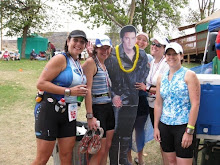Runners who sweat every detail of a workout—pace, distance, effort—may not think twice about a "recovery day" on their training program. After all, rest is easy, right? But while some people are more than happy to take a day on the couch, others can't resist going for a bike ride or even a light three-mile jog. Which is best?
"Recovery days make your training count because your body makes fitness gains while you're at rest," says Brian Glotzbach, head coach of
Personal Best Marathon Coaching in Denver. "If you don't give your body the chance to rebuild, you can't maximize those gains—and certain activities at certain times allow for better recovery."
Choosing what to do on your
easy day to balance out your hard efforts is key to realizing your full potential. But as with any training principle, your own best formula depends on a range of factors including your fitness level, age, and work/life demands. For most runners, however, the following recovery guidelines will help you get the kind of rest you need to get the most out of tough workouts.
RECOVERY DAY: EASY RUN
"Easy runs let your muscles recover while improving your biomechanical efficiency, which translates into improved running form," says Ruth England, a coach for
Rogue Training Systems in Austin, Texas. The key is to make them short enough and slow enough. England recommends going one-third to one-half the distance of your longest runs and slower than you normally run. "Start out glacially slow for five to 10 minutes," says England. "Your breathing should be light and your speed up to two minutes per mile slower than race pace."
DO IT The day after a tempo run, speed workout, or hill repeats
RECOVERY DAY: CROSS-TRAINING
Cycling, swimming, and hitting the elliptical or rowing machines are all good, low-impact ways to hasten the removal of waste products that cause soreness, while correcting muscular imbalances caused by running. However, if your goal is recovery, you shouldn't cross-train for too long or go too hard, says Jim MacWhinnie, a running coach and personal trainer for Core Dynamics in Water Mill, New York. Limit your sessions to 30 to 60 minutes (a bit longer if cycling a flat route). Your heart rate should be elevated, but your breathing shouldn't be labored.
DO IT Whenever you're feeling slightly fatigued or sore, especially the day after a long run or speed workout
RECOVERY DAY: PUMPING IRON
Strength training gives your legs a much-needed break from pounding the pavement and improves your whole-body strength. "More powerful muscles can improve the efficiency of your stride, making you a better runner," says MacWhinnie. "A strong upper body keeps your form from deteriorating and helps you power up hills, while a strong core and lower body absorbs shock better, which can protect you from injury." Maximize your workout time by choosing exercises that work multiple muscle groups at once, such as squats, lunges, push-ups, chin-ups, step-ups, and bent-over rows. Start with two to three sets of six to 12 reps of each exercise. Your muscles should be fatigued by the last rep.
DO IT The day after running
hill repeats or a tempo run
RECOVERY DAY: TOTAL REST
No yoga, no short walks, no pick-up soccer games with the kids (if you can avoid it). "I even tell my runners to take the elevator instead of the stairs," says England. "A day off from activity can be hard for overachievers who think they have to be progressing every single day. But in fact, the training principle of 'super-compensation' suggests that a full day off gives you a bounce in performance. It also gives you a mental break from training."
DO IT Once a week. The day after your long run is ideal, but any day you're feeling out of gas works.
The Easy Plan
HOW YOU PREPARE for and recover from key workouts helps you get the most out of them. Here's what to do before and after your quality days.
LONG RUN
Day Before: Cross-train or total rest
Day After: Cross-train or total rest
SPEEDWORK
Day Before: Cross-train or easy run
Day After: Cross-train, easy run, or total rest
TEMPO RUN OR HILL REPEATS
Day Before: Strength train or easy run
Day After: Strength train or easy run


























